 Circa 100, 8 variants (1968-2017)
Circa 100, 8 variants (1968-2017)
The Russian “Bear” casts its shadow over the USN
To start this new cold war naval aviation section, let’s start not with the USN but the Soviet Navy, giving the fact that using extensive air assets was part of the doctrine to compensate for the numerical inferiority of the Sovietsky Flot when facing the USN Navy. For this, the TU-142 “Bear-F” was one its serious ace in that long range overseas reach. Derived from the Tu-95 “Bear” strategic bomber, it was a Maritime reconnaissance/anti-submarine warfare. It was in fact to be capable of hunting down US submarines first, then deal with taske forces with large antiship missiles, although this role was better taken over by shorte range Tu-16 Badger, Tu-22 Blinder and Tu-26 Backfire naval variants. Stil, this rival of the iconic USAF B-52 bomber had no equivalent in the west, but the P-3 Neptune and P-5 Orion, smaller, slower and shorter range.
Design genesis: The Tu-95 “Bear” strategic bomber
The Tupolev Tu-95, nicknamed “Bear” by NATO, is a long-range strategic bomber and missile platform that has been a symbol of Soviet and later Russian military aviation since the 1950s. It was developed by the Tupolev Design Bureau, first flew in 1952, entered service in the Soviet Air Force in the mid-1950s.
This was is a large, four-engine turboprop aircraft with a distinctive swept-wing design and a double fuselage, featuring contra-rotating propellers reduceing engine vibrations and increasing efficiency. Its primary role was of strategic bomber, capable of carrying nuclear and conventional weapons. It is also later declined for maritime patrol and anti-submarine warfare aircraft. In this role, it carries torpedoes, depth charges, and anti-ship missiles.
The Tu-95 has an impressive range, allowing it to conduct long-range missions. Early variants had a range of over 10,000 kilometers (6,200 miles). Later versions have seen improvements in this regard. It typically has a crew of six, which includes a pilot, co-pilot, navigator, bombardier, and two gunners. The cockpit is located in the forward section of the aircraft.
Nuclear Capabilities was included early on between freefall bombs and cruise missiles, making it a key component of Russia’s nuclear triad, alongside land-based intercontinental ballistic missiles (ICBMs) and submarine-launched ballistic missiles (SLBMs).
The Tu-95 is known for its distinctive and loud “thumping” sound generated by its contra-rotating propellers. This sound is often associated with the aircraft and can be heard from a significant distance. It went through several upgrades and modernization programs over the years to improve its avionics, communication systems, and electronic countermeasures. These upgrades have extended its service life.
It was Exported (both the Tu-95 and Tu-142) to other countries notably India for the latter.
The Tu-95 “Bear” has been a symbol of Russian military aviation and a strategic deterrent for many decades. It remains in service with the Russian Aerospace Forces, and its ongoing presence is a reminder of the Cold War era and the continuing importance of strategic bombers in modern military strategies.
Design of the Tu-142
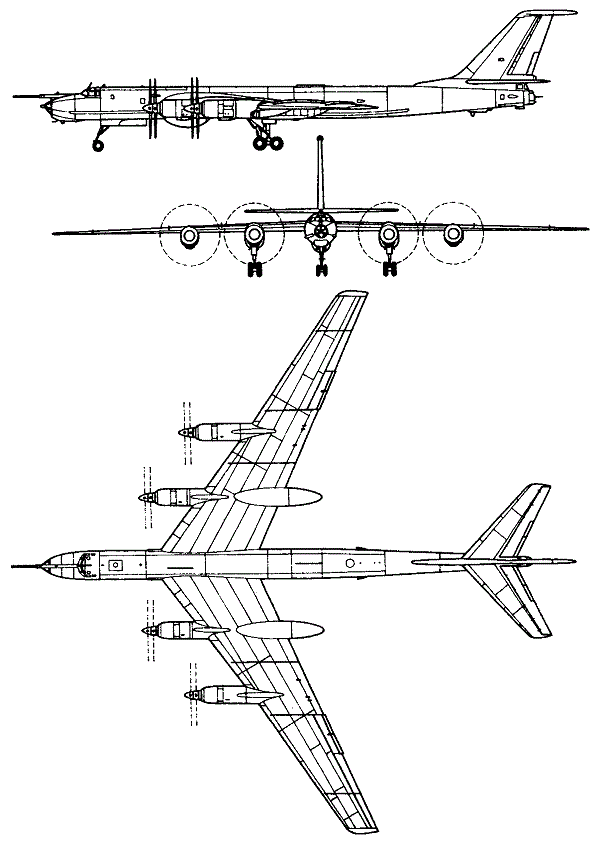
The Tupolev Tu-142, often referred to as the “Bear-F” by NATO, is a maritime patrol and anti-submarine warfare aircraft. It is derived from the Tupolev Tu-95 strategic bomber and shares many design elements with the Tu-95, including its distinctive swept-wing design and contra-rotating propellers. The primary role of the Tu-142 is maritime patrol and anti-submarine warfare. It is used by the Russian Navy and has been operated by other countries as well.
The Tu-142 is a four-engine turboprop aircraft with a double fuselage, similar to the Tu-95. It features a spacious fuselage that can accommodate various mission-specific equipment and sensors.
Anti-Submarine Warfare: The aircraft is equipped with advanced sonar systems, magnetic anomaly detectors, and various anti-submarine weapons, such as torpedoes, depth charges, and anti-ship missiles. Long-Range Capabilities: Like the Tu-95, the Tu-142 has a long operational range, which allows it to conduct extended maritime patrol missions.
Crew: The crew of the Tu-142 typically includes a pilot, co-pilot, navigator, sensor operators, and weapons operators.
Variants: The Tu-142 has seen several variants, including the Tu-142M, Tu-142MR, and others, each with specific mission capabilities and equipment.
Service: The Tu-142 has been used by the Russian Navy and was exported to several other countries, including India, which operated a modified version called the Tu-142ME. India, in particular, used the Tu-142 for long-range maritime patrol and anti-submarine warfare.
Modernization: Like the Tu-95, the Tu-142 has undergone modernization efforts to improve its avionics and mission capabilities.
Variants
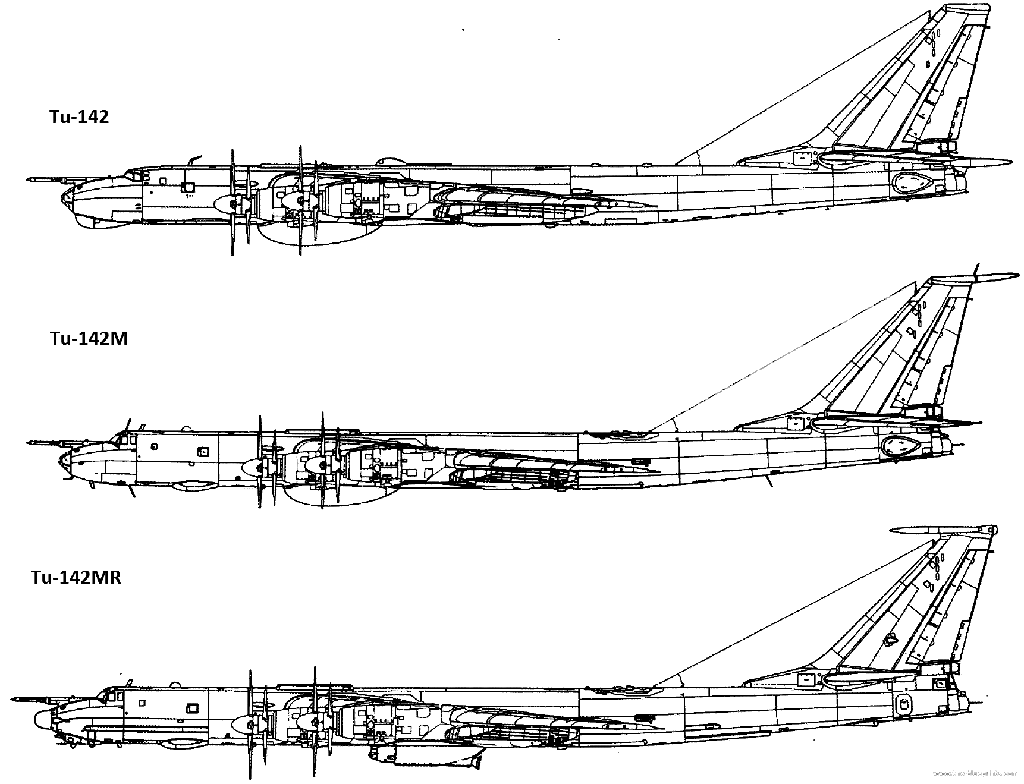
Tu-142
Lengthened Tu-95 with much defensive armament removed, and instead incorporating ASW systems. Twelve aircraft initially had 12-wheel main undercarriage bogies. Six later aircraft had four-wheel bogies. Built by Kuibyshev Aviation Plant.
Tu-142M
30-centimetre (12 in) stretch to front fuselage, redesigned cockpit and two-axle main undercarriage bogies. Built by Taganrog.
Tu-142MK
Greatly improved variant with new Korshun radar, avionics and ASW equipment. 43 Tu-142MKs were constructed by Taganrog.
Tu-142MK-E
Eight downgraded Tu-142MKs purchased by the Indian Naval Air Arm. E stands for “export”.
Tu-142MZ
Last production variant of the “Bear F”, with new NK-12MP engines and a new avionics suite. Can be distinguished from other Tu-142s by its chin fairings. Built by Taganrog
Tu-142MZ-K
Proposed commercial cargo variant of the Tu-142M3 (the K standing for “kommercheskiy”), with ASW avionics removed. Also designated Tu-142M3-C.
Tu-142MP
Modified single Tu-142M used as avionics testbed.
Tu-142MR
Modified Tu-142MKs built as submarine communications relay aircraft. Has distinctive external fairings and components. NATO codename “Bear J”.
Tu-142LL
Two converted earlier Tu-142s used for testing of turbofan engines. ASW equipment was removed.
Operators
USSR/Russia
The Tu-142 were now “owned” by the Soviet Navy but the Soviet Air Forces and were transferred to the Russian Naval Aviation after the dissolution of the Soviet Union.
Operating units from 1972 to 1990:
-35th Long-Range Anti-Submarine Aviation Division – Fedotovo (air base), Vologda Oblast
-76th Long-Range Anti-Submarine Aviation Regiment
-135th Long-Range Anti-Submarine Aviation Regiment
-310th independent Long-Range Anti-Submarine Aviation Regiment – Kamenny Ruchey, Khabarovsk Krai
Russian Naval Aviation (post-1990): 22 Tu-142MZ/MR/MK in service with upgrade with the SVP-24 bombing system ongoing.
-7062nd Port-Arthur Krasnoznamennaya Naval Aviation Air Base – Kamenny Ruchey, Khabarovsk Krai
-568th Composite Aviation Regiment
-2nd Guards Aviation Group – Fedotovo (air base), Vologda Oblast
-403rd Composite Aviation Regiment
Ukraine (post-1990)
The only ones available were captured while stationed at the Mykolaiv Aircraft Repair Plant after the collapse of the Soviet Union. The Mykolaiv Aircraft Repair Plant was providing repairs for many types in the late cold war. By agreement, some Tu-142 later returned to Russia, the remaining were dismantled (START I agreement). However two survived on display, one Tu-142MZ in the Ukraine State Aviation Museum and one early Tu-142 in the Aviation Technical Museum of Luhansk.
India
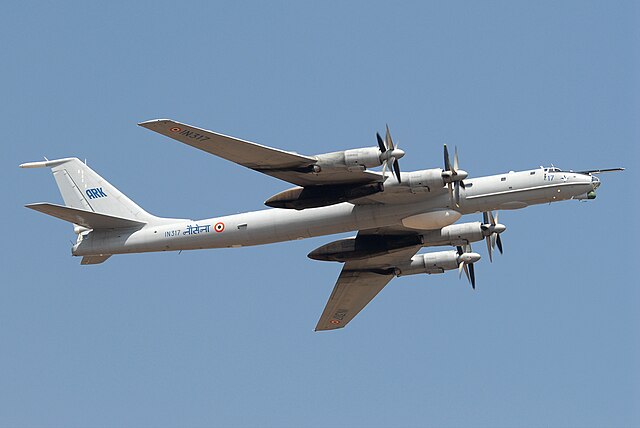
The only operator of the naval variant of the “bear” outside Russia: The Indian Naval Air Arm operated 8 former Soviet Tu-142MK-E aircraft from March 1988 to March 2017 so for 29 years. They were retired on 27 March 2017 during a ceremony at the INS Rajali air base, replaced with jet-powered state of the art Boeing P-8 Poseidon patrollers.
The sole Unit operating these was INAS 312 – INS Rajali, Tamil Nadu.
One is preserved as a museum for public access opposite to the INS Kursura (S20) (museum on the Beach Road, Visakhapatnam) and another Tu-142MK is at the Naval Aircraft Museum, New Town Kolkata.
⚙ Tu-142 specifications |
|
| Empty Weight | 90,000 kg (198,416 lb) |
| Max Takeoff weight | 185,000 kg (407,855 lb) |
| Lenght | 53.08 m (174 ft 2 in) |
| Wingspan | 50 m (164 ft 1 in), airfoil TsAGI SR-5S |
| Height | 12.12 m (39 ft 9 in) |
| Wing Area | 311.1 m2 (3,349 sq ft) |
| Engines | 4× Kuznetsov NK-12MP turboprop engines, 11,033 kW (14,795 shp) each |
| Propellers | 8-bladed contra-rotating constant-speed propellers |
| Top Speed, sea level | 925 km/h (575 mph, 499 kn) |
| Cruise Speed | 711 km/h (442 mph, 384 kn) |
| Range | 6,500 km (4,000 mi, 3,500 nmi) |
| Ceiling | 12,000 m (39,000 ft) |
| Armament | Missiles, ASW torpedoes, depth charges |
| Crew | 11–13, see notes |
Operational History
(To Come)
Read More/Src
Books
Links
https://en.wikipedia.org/wiki/Tupolev_Tu-142

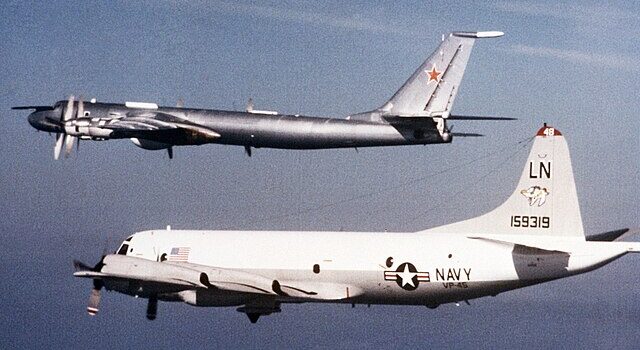
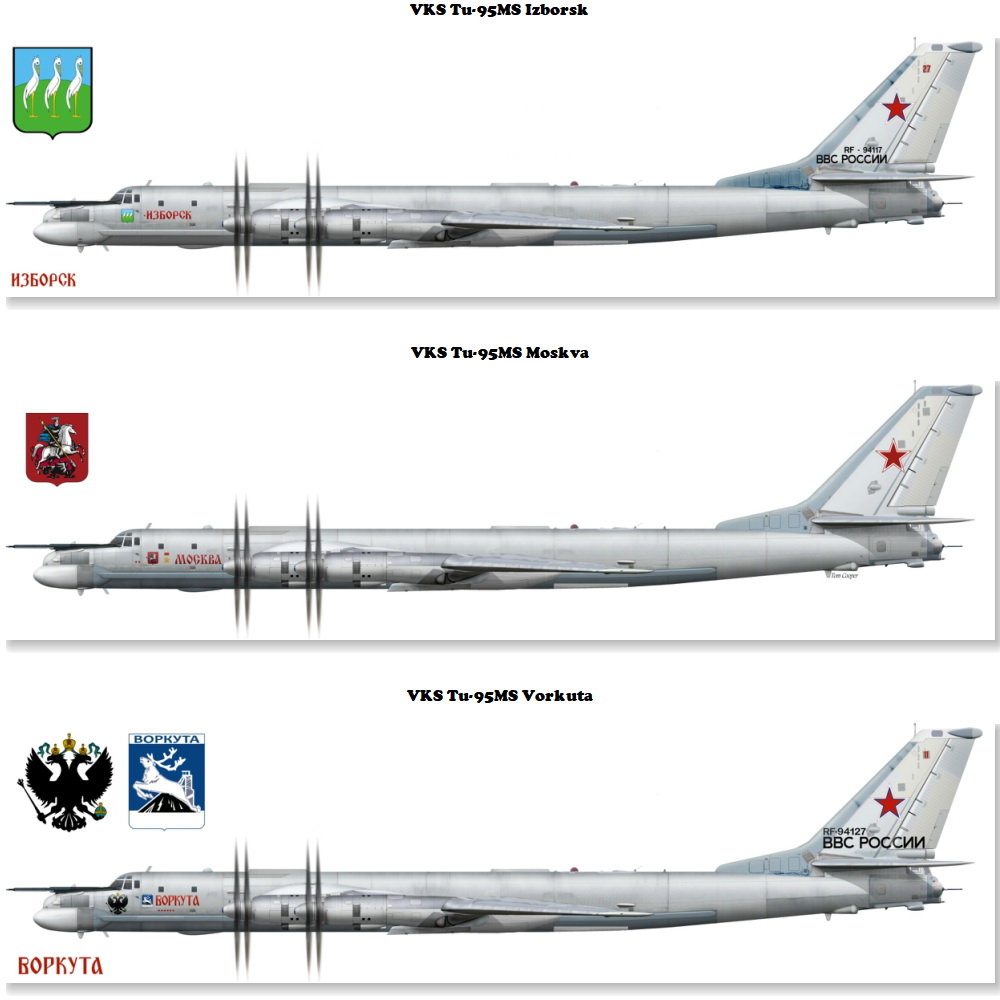
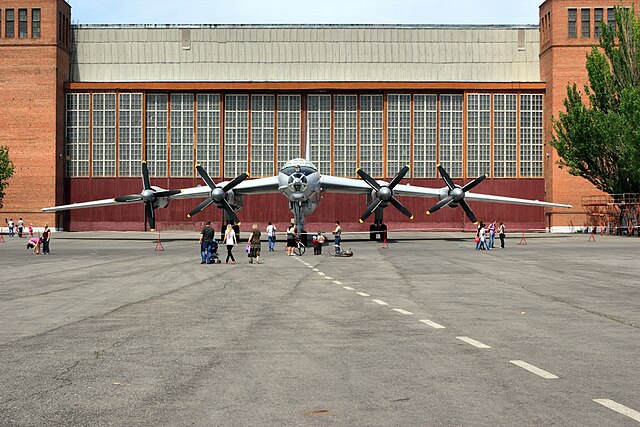
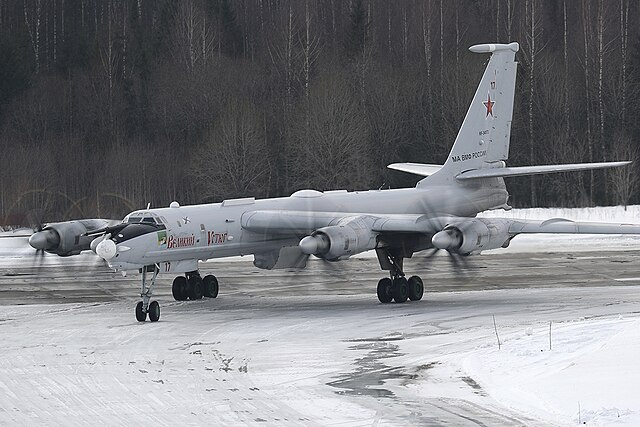
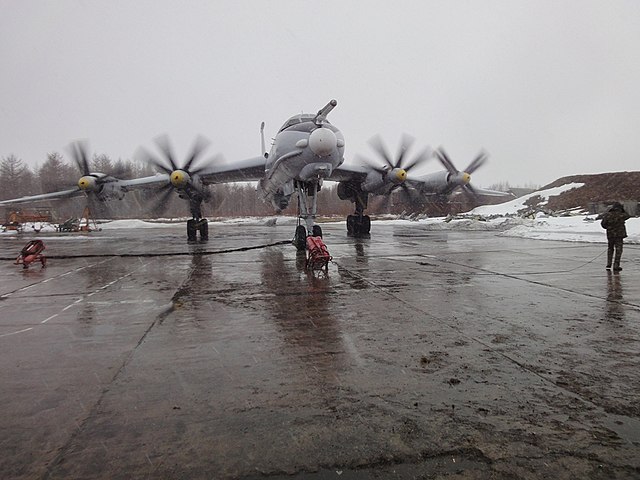
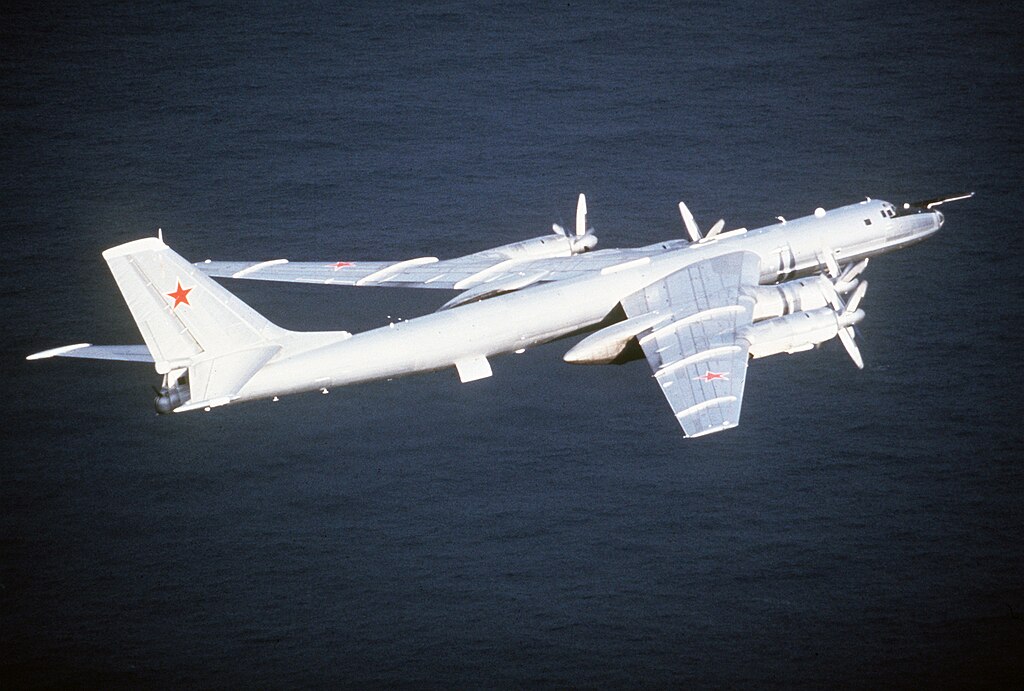
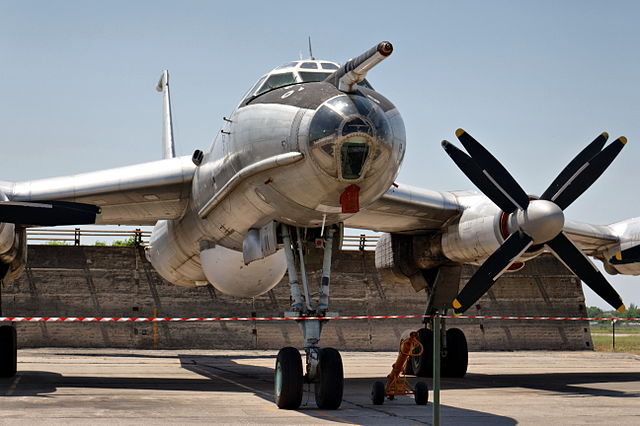
 Latest Facebook Entry -
Latest Facebook Entry -  X(Tweeter) Naval Encyclopedia's deck archive
X(Tweeter) Naval Encyclopedia's deck archive Instagram (@navalencyc)
Instagram (@navalencyc)





 French Navy
French Navy Royal Navy
Royal Navy Russian Navy
Russian Navy Armada Espanola
Armada Espanola Austrian Navy
Austrian Navy K.u.K. Kriegsmarine
K.u.K. Kriegsmarine Dansk Marine
Dansk Marine Nautiko Hellenon
Nautiko Hellenon Koninklije Marine 1870
Koninklije Marine 1870 Marinha do Brasil
Marinha do Brasil Osmanlı Donanması
Osmanlı Donanması Marina Do Peru
Marina Do Peru Marinha do Portugal
Marinha do Portugal Regia Marina 1870
Regia Marina 1870 Nihhon Kaigun 1870
Nihhon Kaigun 1870 Preußische Marine 1870
Preußische Marine 1870 Russkiy Flot 1870
Russkiy Flot 1870 Svenska marinen
Svenska marinen Søværnet
Søværnet Union Navy
Union Navy Confederate Navy
Confederate Navy Armada de Argentina
Armada de Argentina Imperial Chinese Navy
Imperial Chinese Navy Marinha do Portugal
Marinha do Portugal Mexico
Mexico Kaiserliche Marine
Kaiserliche Marine 1898 US Navy
1898 US Navy Sovietskiy Flot
Sovietskiy Flot Royal Canadian Navy
Royal Canadian Navy Royal Australian Navy
Royal Australian Navy RNZN Fleet
RNZN Fleet Chinese Navy 1937
Chinese Navy 1937 Kriegsmarine
Kriegsmarine Chilean Navy
Chilean Navy Danish Navy
Danish Navy Finnish Navy
Finnish Navy Hellenic Navy
Hellenic Navy Polish Navy
Polish Navy Romanian Navy
Romanian Navy Turkish Navy
Turkish Navy Royal Yugoslav Navy
Royal Yugoslav Navy Royal Thai Navy
Royal Thai Navy Minor Navies
Minor Navies Albania
Albania Austria
Austria Belgium
Belgium Columbia
Columbia Costa Rica
Costa Rica Cuba
Cuba Czechoslovakia
Czechoslovakia Dominican Republic
Dominican Republic Haiti
Haiti Hungary
Hungary Honduras
Honduras Estonia
Estonia Iceland
Iceland Eire
Eire Equador
Equador Iran
Iran Iraq
Iraq Latvia
Latvia Liberia
Liberia Lithuania
Lithuania Mandchukuo
Mandchukuo Morocco
Morocco Nicaragua
Nicaragua Persia
Persia San Salvador
San Salvador Sarawak
Sarawak Uruguay
Uruguay Venezuela
Venezuela Zanzibar
Zanzibar Warsaw Pact Navies
Warsaw Pact Navies Bulgaria
Bulgaria Hungary
Hungary

 Bundesmarine
Bundesmarine Dutch Navy
Dutch Navy Hellenic Navy
Hellenic Navy Marina Militare
Marina Militare Yugoslav Navy
Yugoslav Navy Chinese Navy
Chinese Navy Indian Navy
Indian Navy Indonesian Navy
Indonesian Navy JMSDF
JMSDF North Korean Navy
North Korean Navy Pakistani Navy
Pakistani Navy Philippines Navy
Philippines Navy ROKN
ROKN Rep. of Singapore Navy
Rep. of Singapore Navy Taiwanese Navy
Taiwanese Navy IDF Navy
IDF Navy Saudi Navy
Saudi Navy Royal New Zealand Navy
Royal New Zealand Navy Egyptian Navy
Egyptian Navy South African Navy
South African Navy






























 Ukrainian Navy
Ukrainian Navy dbodesign
dbodesign